| Pages:
1
2 |
ronstark
Harmless

Posts: 37
Registered: 10-10-2016
Member Is Offline
Mood: No Mood
|
|
It was extracted with 50mL 50% DCM and 50% CHCl3 (1:1) ratio, washed with a NaCl saturated solution, washed again with water, dried and the solvents
stripped off. The colour is bright yellow, very beautiful. Final yield: 67%. I really don't know why that red / purplish colour was there. I am
satisfied with this result.
[Edited on 11-2-2017 by ronstark]
|
|
|
Magpie
lab constructor
    
Posts: 5939
Registered: 1-11-2003
Location: USA
Member Is Offline
Mood: Chemistry: the subtle science.
|
|
I am glad this synthesis worked out so well for you. That's an amazing yield compared to what Vogel claimed, which was 37%.
I did find a note in an internet dictionary that said salicylaldehyde was soluble in benzene. So xylene would probably be good also.
The single most important condition for a successful synthesis is good mixing - Nicodem
|
|
|
cubalibre
Harmless

Posts: 11
Registered: 3-10-2016
Member Is Offline
Mood: H2 saturated
|
|
If you liberate phenolic aldehyde adducts with NaOH, you must neutralize it afterwards otherwise you will loose product with your aqueous washes.
Very likely the reason they do it using H2SO4 in Vogel in the first place.
[Edited on 12-2-2017 by cubalibre]
|
|
|
ronstark
Harmless

Posts: 37
Registered: 10-10-2016
Member Is Offline
Mood: No Mood
|
|
It was neutralized with HCl 36.5% until pH was neutral. Forgot to mention that.
[Edited on 12-2-2017 by ronstark]
|
|
|
RustyShackleford
Hazard to Others
  
Posts: 200
Registered: 10-12-2020
Location: Northern Europe
Member Is Offline
|
|
I attempted this preparation, with the differences being using Kmetabisulfite , crashing more adduct with acetone and ofcourse a huge experience and
knowledge gap between me and magpie (bless his soul).
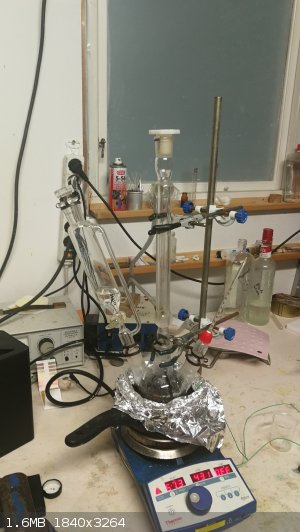
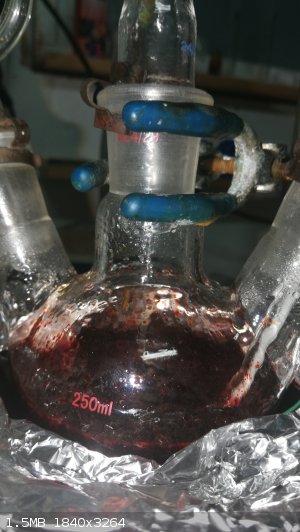
The reaction mixture formed a thick slurry of goop, i think a flatbottom 3neck with a large stirbar would have been much preferable.
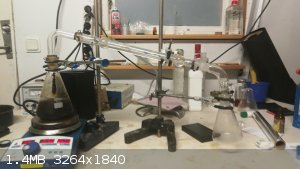
The steam distillation seemingly went quite well, i stopped after the drips reached clarity.
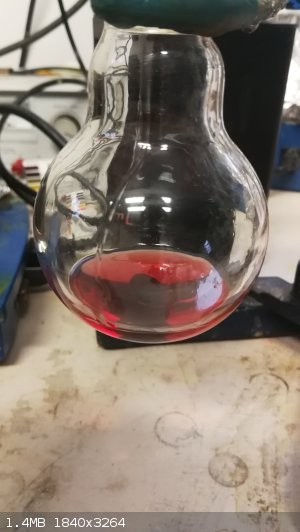
This is where it started to get wierd, the DCM extracted organics from the steam distillation were VERY red, but sufite reduced this to a dirty
yellow.
After stirring the organics with metabisulfite solution for 4h, nothing had precipiated (but it had become homogenous), so i decided to evaporate it.
and chill. After filtering i added 3x the filtrates volume of acetone to crash out more of the adduct while hopefully keeping the phenol dissolved.
This made it very yellow but seemingly worked well.
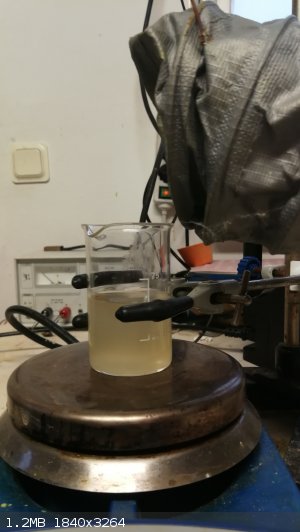
Sadly i dont have an image of the acid degradation or distillation of the salicylaldehyde, but notably after extracting the acidic solution with DCM
it again turned red. Distilling didnt separate this color.
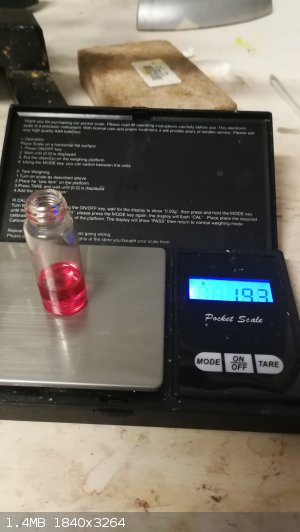
Final yield was 15% assuming the distillate is mostly pure.
Dont do this preparation yourself, make/get formaldehyde and do the Mg mediated formylation, this sucked
Small thing of note: a solution of oxone was used to rid the recovered DCM of SO2, worked great.
[Edited on 19-1-2021 by RustyShackleford]
|
|
|
Fery
International Hazard
    
Posts: 1016
Registered: 27-8-2019
Location: Czechoslovakia
Member Is Offline
|
|
Hi RustyShackleford, very well done! My old commercial salicylaldehyde is pale yellow, as magpie. I did not try to redistill it, maybe it would be
colorless then. Strange that the distillation did not separate the red color in your case. Did you distill it at atmospheric pressure, or vacuum?
Vacuum would significantly reduce oxidation to salicylic acid, but small contamination with this acid (if distilling at atm pressure) should not be
the case of the red color. Phenolic compounds are able to produce very colored complexes with metals, e.g. with Fe3+, like here:
https://sci-hub.st/10.1021/ja01124a041
But this should not be your case as you certainly used glass distillation apparatus.
|
|
|
RustyShackleford
Hazard to Others
  
Posts: 200
Registered: 10-12-2020
Location: Northern Europe
Member Is Offline
|
|
Fery, i distilled at atmospheric pressure and ofcourse did use an all glass distillation vessel, but if the color complex is very potent i guess its
possible there was some contamination in my glassware that re-formed the red compound after it condensed.
|
|
|
Pumukli
National Hazard
   
Posts: 705
Registered: 2-3-2014
Location: EU
Member Is Offline
Mood: No Mood
|
|
Maybe the red color means there is unreacted phenol that is oxidized. Phenol distills with steam as far as I know.
On the other hand I read somewhere that hydroxy aldehydes resist oxidation pretty well. Salicylaldehyde was explicitely mentioned. Maybe it is only
true at room temp, I 'm not sure.
|
|
|
RustyShackleford
Hazard to Others
  
Posts: 200
Registered: 10-12-2020
Location: Northern Europe
Member Is Offline
|
|
Quote: Originally posted by Pumukli  | Maybe the red color means there is unreacted phenol that is oxidized. Phenol distills with steam as far as I know.
On the other hand I read somewhere that hydroxy aldehydes resist oxidation pretty well. Salicylaldehyde was explicitely mentioned. Maybe it is only
true at room temp, I 'm not sure. |
I think this is the case, it has turned a little bit more red over time so its more likely to be oxidation than a complex
|
|
|
Fery
International Hazard
    
Posts: 1016
Registered: 27-8-2019
Location: Czechoslovakia
Member Is Offline
|
|
Just an idea, but couldn't it be purified by partial crystallization, its melting point is -7 C so putting into a freezer with -18 C for some short
time so not the whole content solidifies?
|
|
|
zed
International Hazard
    
Posts: 2283
Registered: 6-9-2008
Location: Great State of Jefferson, City of Portland
Member Is Offline
Mood: Semi-repentant Sith Lord
|
|
The way I remember it, Benzaldehyde loves to be oxidized. Moreover, it loves to oxidize/reduce itself into two more stable conformations... Benzyl
Alcohol and Benzoic Acid. I can remember Ancient Bottles of Benzaldehyde in the Chem Storeroom.... where I used to work; Packed with crystals of
Benzoic Acid they were.
The Cannizarro used to be a favorite College Organic Chemistry Experiment. Back, before the federal government, in the USA, became totally paranoid
about Benzaldehyde.
This Oxidation, or base catalyzed re/dox tendency, is not automatic for all Benzaldehydes. Seems I've read that Vanillin is less likely to do it than
Benzaldehyde.
Perhaps that Phenolic "Acidity", produces some stability.
As for the "Red" Salicaldehyde. Benzaldehyde itself, is supposed to be distilled under reduced pressure.
In general, aldehydes are very reactive. I'm thinking steam distill from an acetic solution, or distill under reduced pressure.
[Edited on 24-2-2021 by zed]
[Edited on 24-2-2021 by zed]
|
|
|
clearly_not_atara
International Hazard
    
Posts: 2788
Registered: 3-11-2013
Member Is Offline
Mood: Big
|
|
Arenes with a formyl group that is ortho or para to a hydroxyl group show a resonance isomerization when the phenol is deprotonated, which inhibits
both A: the Cannizzarro reaction and also B: the alkylation of the phenol. This is why the bromination of vanillin works, and also why the methylation
of salicylaldehyde or syringaldehyde usually requires high temperatures.
|
|
|
| Pages:
1
2 |